Can You Give Me A Lift?
Duration: 60 minutes
Grade Levels: 4-12
This lesson was created to prepare students for the 2026 Tech Challenge: Raise the Roof.
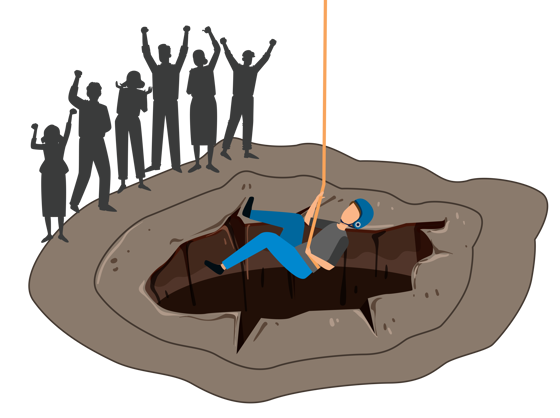
Students will explore strategies for building a device that can lower into a hole and lift out a person stuck at the bottom.
Grade Levels: 4-12
Duration: 60 minutes
Concepts/Skills: Forces, balance, pulleys, simple machines, weight distribution
Objectives:
Students will:
- Build a device that can be lowered and lift something up.
- Design a solution using only the limited materials available.
- Consider how to keep the item safe while being lifted.
Outline
Frame the Challenge |
10 min total |
|
Activate Prior Knowledge |
5 min |
|
Introduce the Challenge |
5 min |
Design Challenge |
25 min total |
|
Prototyping (Build and Test) |
15 min |
|
Quick shareout |
5 min |
Iteration |
25 min total |
|
Introduce New Criteria and Iterate |
15 min |
|
Share Solutions |
10 min |
|
Debrief |
5 min |
 Materials
Materials
- Testing Materials (at least 1 set per class)
- Table or surface edge
- Garbage can/ tall container
- Masking tape
- Small toy or plushie
- Each team will need:
- Scissors
- Paper bag ("backpack")
- Building materials (see below)
Building Materials
Fill a “backpack” or bag for each team with a variety of materials from the categories listed below. We recommend that each bag contains:
- 1 string or rope (3 ft)
- 1 base
- 2 types of round objects
- 2 types of long item
- 3 types of connectors
![]() Tip: Give each team a different set of materials to encourage a variety of solutions. See the table below for examples of some of the categories of things to choose from.
Tip: Give each team a different set of materials to encourage a variety of solutions. See the table below for examples of some of the categories of things to choose from.
Look for items that:
| Have surface area. | Are long and skinny. | Are round or spherical. |
|
|
|
| Can be connectors. | Can act as counterweights (optional) |
|
|
![]() Tip: Don’t use glue and limit the use of tape. This allows for faster iteration, more reuse of materials, and less mess.
Tip: Don’t use glue and limit the use of tape. This allows for faster iteration, more reuse of materials, and less mess.
Natural Materials (optional)
You can also give teams the option incorporating natural materials found in the surrounding environment into their design. This will encourage them to creatively consider how they would engineer a solution in the real world. Gather some of the natural materials listed below and have them available for students in the room.
- Rocks
- Sticks
- Bark
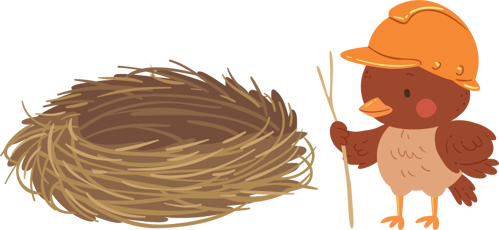
Testing Set-up
- Designate a table or another surface edge for the testing location. The surface edge needs to be at least 2.5 ft (0.76 m) from the floor.
- Place the garbage can/tall container underneath the surface edge. The container needs to be at least 1.5 ft (0.4 m) tall and 1 ft (0.3 m) wide.
- See the Test Rig Set-up by Gradeband Table for container placement options.
- Have masking tape available in the test area as some teams may need to secure their device to the table during testing. Limit their use of tape to 8 inches for each round of testing.
Test Rig Diagram (Design notes)
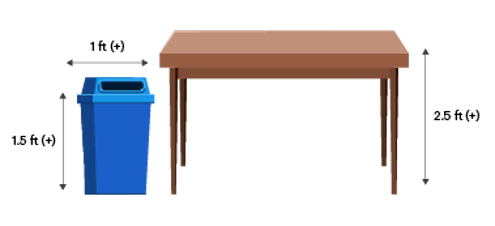
![]() Beginning Engineers
Beginning Engineers
Move the container closer to the surface edge so students only have to practice lifting vertically.
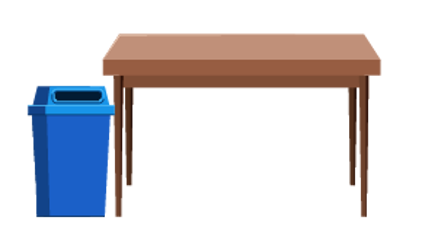
Container located directly under the surface edge.
![]() Advanced engineers
Advanced engineers
Challenge students to build a device that can reach further from the table. With this set-up students will need to consider balance and horizontal motion.
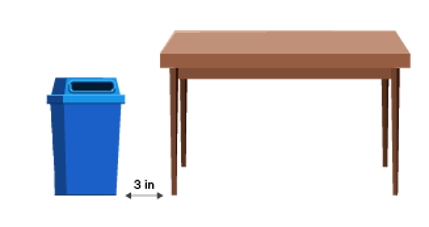
Container located 1 inch away from the surface edge.
 Preparation
Preparation
- Prepare one backpack for each team by adding the materials highlighted above.
- Place the natural materials on a table that students can access during building.
- Try out the activity yourself, with other educators or kids you know. This will give you practice with the resources so you can anticipate student questions.
 Frame the Challenge
Frame the Challenge
Activate Prior Knowledge (5 min)
- Ask learners to think about a time when they lost an item down a hard to reach place (behind the couch, down a sewer grate, etc.).
- What factors made it challenging to reach the item?
- Did you use any tools to help you retrieve the item?
- How did you make sure the item wouldn’t be damaged in the process?
- Now have the learners to consider what they might need to do if they needed to lift out something larger and heavier.
- What tools could help you lift out an object that is heavy?
- What kind of machines are designed to lift heavy objects? What kinds of features do they have?
- Let the learners know that they will be working in their Tech Challenge teams to figure out how to lift out a person that is stuck at the bottom of a hole.
Introduce the Challenge (5 min)
- Introduce the design scenario:
Design Scenario You are on a team of engineers working on a construction site in a remote area of California. Unfortunately the ground was weaker than expected due to recent heavy rain. This has caused a sinkhole to appear, and one of the workers has fallen into it! Fortunately they are not hurt, but the sinkhole is too deep for them to climb out. Since the area is remote and requires offroad driving to reach, it could take several hours for help to arrive. You and your team think they can come up with a way to get the worker out, but they only have the limited supplies they brought.
- Introduce the design problem, criteria, and constraints:
Design Problem Design a device that can safely lift a person out of the hole
Criteria - Design can only include materials from backpack (paper bag) and the surrounding environment (natural materials)
- Design cannot be supported or held up by humans.
Constraints
- There’s a time limit!
- Show learners an example of the backpack and included materials.
- Identify each item by its category instead of its name to help them think about how it might be used.
- Ex: Hold up a rubber band and a pipe cleaner and tell them they have two connectors.
- Let learners know they will be sharing their findings with the rest of the class and giving each other feedback.
 Researching Solutions
Researching Solutions
Finding inspiration from real-world solutions can be useful when starting a design challenge. Provide your students with practice researching and even brainstorming before they start building.
Try adding in elements from our Researching Solutions lesson plan.
This lesson is designed to guide teams participating in The Tech Challenge with strategies for researching the design problem and using the information to brainstorm.
 Design Challenge
Design Challenge
Prototyping (Build and Test) (15 min)
- Have learners get into their Tech Challenge teams.
- If the class is not preparing for the Tech Challenge, have them get into teams of 3–4.
- Pass out one backpack/bag to each team and have them start building.
- During the prototyping time, support teams with open ended Prototyping Questions to guide the process:
- What are some potential ways the materials in your backpack could be used to build your device?
- How safe is the passenger on the way back up? Is there any potential of them accidentally bumping into the walls during the ride?
- How do you reset the device after using it? Is there a way to build an automatic reset feature into it?
Pulleys
Teams may want to consider creating a pulley to organize the string and make it simple to wind the string back up when lifting out the passenger.
Examples of pulleys in the real world and things they are used in include:
- Garage doors, window blinds, curtains, flag pole, cranes, and well buckets
Use string to lift or lower something.
![]()
Tip: Keep the area around strings clear and try using counterweights to slow things down.
Quick Shareout (5 min)
- At the end of the time limit, have teams stop even if they haven’t been able to test yet.
- Ask for volunteers to share what they have noticed and wondered as they prototyped.
- As needed, remind students that the goal is for everyone to get rescued, so this is a good time to share what they have learned so far with each other.
 Iterate
Iterate
Introduce new criteria and iterate (15 min)
- Next, introduce a new design scenario:
- While you were building your device, you accidentally knocked some of your supplies into the hole! Now, not only do you not have those materials to build with, but you’ll need to be able to bring up the person and the fallen materials at the same time. Don’t forget you can also use items from the surrounding environment in your design.
- Introduce new criteria:
Design Problem Design a device that can safely lift a person out of the hole
Criteria - Design can only include materials from backpack (paper bag) or the surrounding environment (natural materials)
- Design must be attached to the surface edge.
- New criteria: Design must now carry the person and the fallen materials out of the hole at the same time.
Constraints
- There’s a time limit!
- New constraint: Remove 1 round object and 1 long item from each backpack.
- Have learners get back into their teams again and begin iterating on their design.
- Bring the class back together when the time is up.
 Weight Distribution
Weight Distribution
During testing, teams may notice the passenger will sway back and forth as they try to lift them out. This is because the passenger has added extra weight, pulling the energy downward. Teams will need to carefully consider how to distribute weight across their whole device so it remains balanced while lifting the passenger out.
Having small items like erasers, game pieces, or washers available to act as counterweights may be useful.

Share Solutions (10 min)
- Have all teams show their final designs by demonstrating them at the test rig.
- After all the teams have demonstrated their designs, ask teams to do a final share out. Possible Sharing Questions could include:
- Tell us how your device retrieves the passenger and the fallen items.
- How did you change your design once you lost some of your building materials?
- Would you make any other changes if you had more time?
- Invite students to continue to give positive feedback on other team’s designs and encourage them to share suggestions.
Debrief (5 min)
- After students share their solutions, lead a short debrief with some of these questions. Possible Debrief Questions include:
- What was it like having to design a solution with limited materials?
- What are other situations where you might need to lift and move a heavy object? Would you have built your device differently for this situation?
- Where else do you see simple machines like pulleys used in your daily life?
Standards Connections
| Next Generation Science Standards | ||
| Grade | Performance Expectation | Description |
| 3 | PS2-1 |
Plan and conduct an investigation to provide evidence of the effects of balanced and unbalanced forces on the motion of an object. |
|
MS |
ETS1-1 | Define the criteria and constraints of a design problem with sufficient precision to ensure a successful solution, taking into account relevant scientific principles and potential impacts on people and the natural environment that may limit possible solutions. |
|
PS2-2 |
Plan an investigation to provide evidence that the change in an object’s motion depends on the sum of the forces on the object and the mass of the object. |
|
|
HS |
PS3-3 | Design, build, and refine a device that works within given constraints to convert one form of energy into another form of energy |
|
ETS1-3 |
Evaluate a solution to a complex real-world problem based on prioritized criteria and trade-offs that account for a range of constraints, including cost, safety, reliability, and aesthetics as well as possible social, cultural, and environmental impacts. |
|
| Science and Engineering Practices |
Asking Questions and Defining Problems Planning and Carrying Out Investigations |
|
| Cross Cutting Concepts |
Patterns Cause and Effect |
|
Vocabulary
| Term | Definition |
|
Construction |
The building of things such as houses, factories, roads, and bridges. |
|
Counterweight |
Weights added to the crane to offset the load and prevent tipping. |
|
Natural materials |
Items found in nature. |
|
Pulley |
A wheel on an axle or shaft enabling a taut cable or belt passing over the wheel to move and change direction, or transfer power between itself and a shaft. |
|
Sway |
To swing or move from side to side. |
|
Weight distribution |
The way in which the weight of an object is distributed across its structure or components/ |

The Tech Challenge
This lesson was created to prepare students for the 2026 Tech Challenge: Raise the Roof. This lesson will:
- Introduce students to building devices that can lift and maneuver objects to another location.
- Familiarize them with related science concepts such as weight distribution, balance, and the use of simple machines.
To learn more about this year's Tech Challenge, go to thetech.org/thetechchallenge
 Skip Navigation
Skip Navigation


